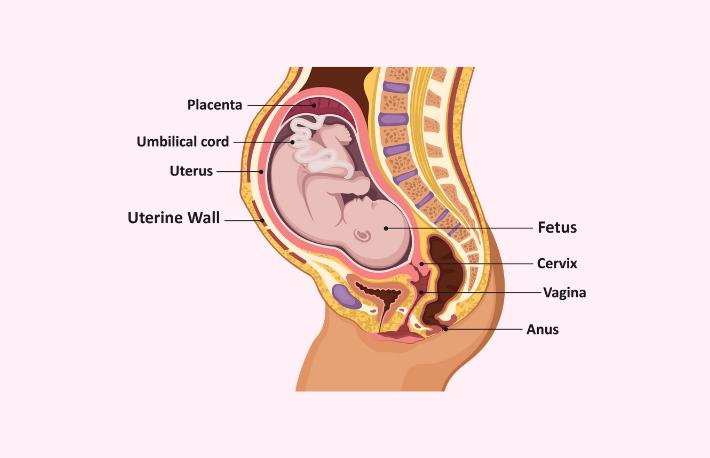
Internal Fetal Monitor: Function, Risks, And Precautions
An internal fetal monitor is a constant test that records all your contractions and the heart rate of your baby. The internal fetal monitor helps indicate any fetal distress at the time of labor and delivery.
Providers use internal fetal monitors widely. However, experts recommend it only when you have a pregnancy with many complications.
The process of internal fetal monitoring involves an electrode that is placed directly on the baby’s scalp while it is still in the mother’s womb. This test is done to evaluate the heart rate of the baby along with the inconsistency of heartbeats during labor.
While internal fetal monitor is used only for high risk pregnancies, it can also be used in case of low risk births if the doctor’s teams is unable to get an accurate reading from the rest of the monitoring techniques like electronic fetal monitoring or auscultation.
Do you wish to know more about an internal fetal monitor? Stay with us till the end of the article to find out!
What Is An Internal Fetal Monitor?

In this process, the internal fetal monitor is inserted through the woman’s cervix to the part of the fetus’ body that is closest to the opening. In most cases, it is usually the scalp. If the mother’s water is not broken, an amniotomy will be done to do so. Then, a fetal electrode will be placed by screwing a thin wire into the top layers of the baby’s scalp.
At the very same time, an intrauterine pressure catheter might also be placed inside the uterus, right in between the uterine wall and the baby. This also lets the birthing team get the measurement of the accurate contractions of the mother rather than depending on the less reliable processes of external monitoring, This is particularly beneficial when an induced labor is indicated.
Anatomy Of The Fetus

Amniotic Sac
This is a very thin-walled sac surrounding the fetus at the time of pregnancy. This is full of amniotic fluid and the amnion that protects the fetus from any injury. It also helps in regulating the temperature of the fetus.
Anus
The end opening of the anal canal
Cervix
This is the lower part of the uterus that is projected into the vagina. The cervix is made up mostly of fibrous tissues and muscles. And it is circular in shape.
Fetus
The unborn baby from the eighth week till the end of the pregnancy.
Placenta
It is an organ that is shaped like a flat cake. It only grows during pregnancy and causes a metabolic exchange between the mother and the fetus.
Umbilical Cord
This is a rope like structure connecting the fetus to the placenta. The umbilical cord is a set of two arteries and one vein. They are responsible for carrying nutrients and oxygen to the fetus and waste products away from the fetus.
Uterine Wall
This is the wall of the uterus
Uterus
The uterus is also known as the womb of the mother. This is a hollow, pear shaped organ present in the lower abdomen of the woman. It is present right between the rectum and the bladder. Women go through their menstrual cycle due to the shedding of the uterine wall. At the time of implantation, the fertilized egg attaches itself to the wall of the uterus and develops there itself.
Vagina
This is a part of the female genitals. It is present right behind the bladder and in front of the rectum. It is like a canal that extends from the uterus to the vulva.
Reasons For Internal Fetal Monitor
The internal fetal monitor is used in almost every early pregnancy to evaluate fetal well-being and identify any such changes that are associated with the issues during pregnancy or during labor.
The process of internal fetal monitoring is particularly beneficial for all the high-rate pregnancy situations like high blood pressure, diabetes, and issues with fetal growth.

Situations at the time of pregnancy where fetal heart rate monitoring may be used include, but are certainly not limited to, evaluation of the fetal heart rate at the time of prenatal physical checkups and monitoring the effects of preterm labor medicines on the fetus.
Fetal heart rate monitoring might be used as an element of some other procedures that might include:
- Nonstress test
- Contraction test
- Biophysical test
Situations at the time of labor that might affect the fetal heart rate growth and for which an internal fetal monitor might be used include:
- Uterine contractions
- Procedures performed at the time of labor
- Pain medicines or anesthetic elements given to the mother at the time of labor
- Pushing at the time of the second stage of labor
There might be other reasons, too, for which your doctor might suggest you go for an internal fetal monitor.
Risks Of Internal Fetal Monitor

- No radiation is used, and usually, no discomfort arises from the application of the transducer to the abdominal skin.
- The elastic belts holding the ultrasound and pressure transducer in place around the abdomen, however, might be a tad bit uncomfortable. These can easily be readjusted. So you can ensure that you are just as comfortable as you can be.
- In most cases of an internal fetal monitor, you might need to lie still.
- In the case of an internal fetal monitor, however, you might feel a slight discomfort while the doctor inserts the electrode.
- The risks of internal monitoring include some bruising of the fetal scalp or other parts of the body and infection
- Internal fetal monitor is contraindicated in some women who have active herpes lesions on the vagina or the cervix due to the risk of transferring the infection right to the fetus.
- There are other risks too that depend on specific medical conditions. So, you need to be sure to discuss any concern with the doctor before getting the procedure done.
Some factors or conditions might interfere with the results of the test. These results might include:
- Position of the mother or the fetus
- Obesity of the mother
- Excessive amniotic fluid
- Inadequate dilation of the cervix or amniotic sac not broken
Before The Internal Fetal Monitor

- Your doctor will explain the entire procedure to you and give you the chance to ask any questions that you may have about the procedure.
- You would have to sign the consent form that confirms your permission to continue with the procedure. Go through the form carefully and ask question if something is not clear to you. The consent form for a fetal heart rate monitoring might be included as a portion of the general consent form for the labor and birth.
- If the fetal heart rate monitoring is done in conjunction with another monitoring process, like the nonstress test or biophysical profile, you might be asked to eat a proper meal before doing the procedure. This will allow for increased fetal activity. You might or might not be able to drink or eat anything with the internal fetal monitor at the time of labor.
- Although a gel is applied on the skin at the time of the process which will not stain any of your clothes, it is better to wear some old clothes or a hospital gown as the gel might not get removed totally from your skin later on.
- Placement of the internal electrode needs for the amniotic membranes to be broken and the cervix dilated by many centemeters to be able to contract with other parts of the body.
- Depending on your medical condition, your doctor asks you to make specific preparations.
During The Internal Fetal Monitor Process

- The process of internal fetal monitoring might be done in the office of your doctor, on an outpatient basis, or as a part of your stay in the hospital. The process may very depending on the condition of the mother and he practices of the hospital.
- Usually, the process of internal heart rate monitoring deals with the following steps:
- The doctor will ask you to completely undress and put on the hospital gown. You will then lie down on the labor bed with support on your legs and feet for a pelvic exam.
- The doctor or the nurse will do a vaginal examination with gloves in their hand to check for cervical dilation. This might feel slightly uncomfortable.
- If the amniotic sac is still in its proper shape, the doctor might have to break open the membranes with the help of an instrument. You will feel a very warm fluid come out of your vagina.
- The doctor will feel part of the baby at the cervical opening with his gloved fingers. This is generally the head of the baby.
- Your doctor will then insert a long, plastic electrode in your vagina. A tiny spiral wire at the end of the electrode will touch the fetal head and softly rotate on the fetal skin.
- The guide will then be removed and the electrode will remain in its place, attached to the fetal head.
- The electrode wires will then be connected to a monitor cable and tied with a band around the thigh.
- You might not be allowed to move or get out of bed while the internal fetal monitor is operating.
- Upon the delivery of the baby, the electrode is removed.
After The Procedure

You do not need to do any special type of care after doing an external fetal heart rate monitoring. You can continue with your usual diet and activities unless your doctor advises you against it.
However, after an internal fetal monitoring, the electrode area on the newborn will be set for examination for any bruising, infection, or a laceration. The area might be cleansed with antiseptics.
Your doctor might also give you alternate or additional instructions after doing the procedure based on your particular situation.
Precautions
The internal fetal monitor is a complicated procedure, and the patients expectedly do not know everything. So, if your doctor suggests you an internal fetal monitor, make sure you know the following before signing the consent form:
- The name of the procedure or the test
- The reason which you need to go through with this test
- What results to anticipate and what do they mean
- Both the benefits and the risks of the procedure
- The possible complications and the side effects associated with the procedure
- When and where do you need to get this procedure done
- Who will be performing the procedure on you, and what are their medical qualification
- What will happen if you do not choose to do this procedure
- Any alternative test to look for
- When and how are you going to get the results
- Who to call after the test if you are having problems with questions
- How much would you have to pay for the procedure or test
Frequently Asked Questions
An internal fetal monitor cannot just be performed on any pregnant woman. This can only be done when the cervix has dilated enough and the amniotic sac is broken.
Internal monitoring is the only solution when all other techniques of external monitoring have failed. This procedure is done to get closer look at the heartbeat of the baby.
In case of pregnancies with no complications, it is suggested that internal heart monitoring be done every 15 to 30 minutes within the first stage of labor. The number keeps increasing with an increase in labor.
The Bottom Line
Internal fetal monitor is a process where the heartbeat of the baby is checked at the time of delivery. This procedure is only done when all the other external monitoring procedures fail.
However, this process comes with certain risks. The doctor inserts an electrode placing it on the head of the fetus. This sometimes can be a reason behind infections or bruising on the baby’s head. However, internal fetal monitor is not for everyone. It is only doable when the cervix has enough dilation, and the amniotic sac is broken.
If your doctor suggests you go for this procedure, make sure you know every single detail, benefit, and risk, before signing the consent form.
RECOMMENDED READING:
Already have an account?
Sign In
Create your account
User added successfully. Log in








